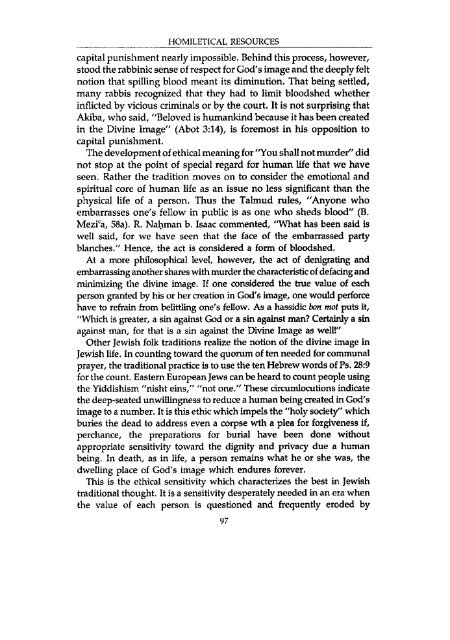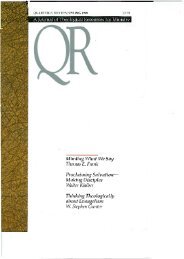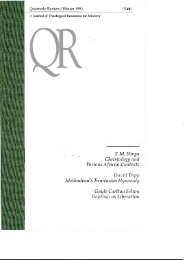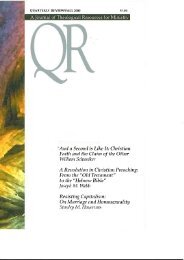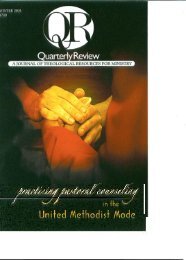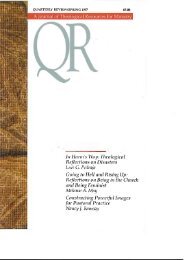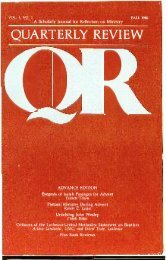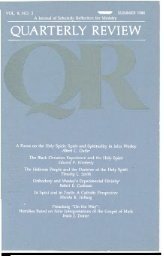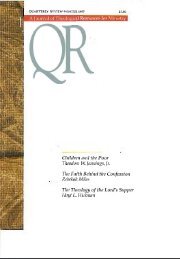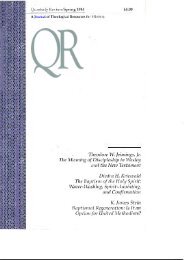Winter 1984 - 1985 - Quarterly Review
Winter 1984 - 1985 - Quarterly Review
Winter 1984 - 1985 - Quarterly Review
You also want an ePaper? Increase the reach of your titles
YUMPU automatically turns print PDFs into web optimized ePapers that Google loves.
HOMILETICAL RESOURCES<br />
capital punishment nearly impossible. Behind this process, however,<br />
stood the rabbinic sense of respect for God's image and the deeply felt<br />
notion that spilling blood meant its diminution. That being settled,<br />
many rabbis recognized that they had to limit bloodshed whether<br />
inflicted by vicious criminals or by the court. It is not surprising that<br />
Akiba, who said, "Beloved is humankind because it has been created<br />
in the Divine Image" (Abot 3:14), is foremost in his opposition to<br />
capital punishment.<br />
The development of ethical meaning for "You shall not murder" did<br />
not stop at the point of special regard for human life that we have<br />
seen. Rather the tradition moves on to consider the emotional and<br />
spiritual core of human life as an issue no less significant than the<br />
physical life of a person. Thus the Talmud rules, "Anyone who<br />
embarrasses one's fellow in public is as one who sheds blood" (B.<br />
Mezi c a, 58a). R. Nahman b. Isaac commented, "What has been said is<br />
well said, for we have seen that the face of the embarrassed party<br />
blanches." Hence, the act is considered a form of bloodshed.<br />
At a more philosophical level, however, the act of denigrating and<br />
embarrassing another shares with murder the characteristic of defacing and<br />
rninimizing the divine image. If one considered the true value of each<br />
person granted by his or her creation in God's image, one would perforce<br />
have to refrain from belittling one's fellow. As a hassidic bon mot puts it,<br />
"Which is greater, a sin against God or a sin against man? Certainly a sin<br />
against man, for that is a sin against the Divine Image as well!"<br />
Other Jewish folk traditions realize the notion of the divine image in<br />
Jewish life. In counting toward the quorum of ten needed for communal<br />
prayer, the traditional practice is to use the ten Hebrew words of Ps. 28:9<br />
for the count. Eastern European Jews can be heard to count people using<br />
the Yiddishism "nisht eins," "not one." These circumlocutions indicate<br />
the deep-seated unwillingness to reduce a human being created in God's<br />
image to a number. It is this ethic which impels the "holy society" which<br />
buries the dead to address even a corpse wth a plea for forgiveness if,<br />
perchance, the preparations for burial have been done without<br />
appropriate sensitivity toward the dignity and privacy due a human<br />
being. In death, as in life, a person remains what he or she was, the<br />
dwelling place of God's image which endures forever.<br />
This is the ethical sensitivity which characterizes the best in Jewish<br />
traditional thought. It is a sensitivity desperately needed in an era when<br />
the value of each person is questioned and frequently eroded by<br />
97


